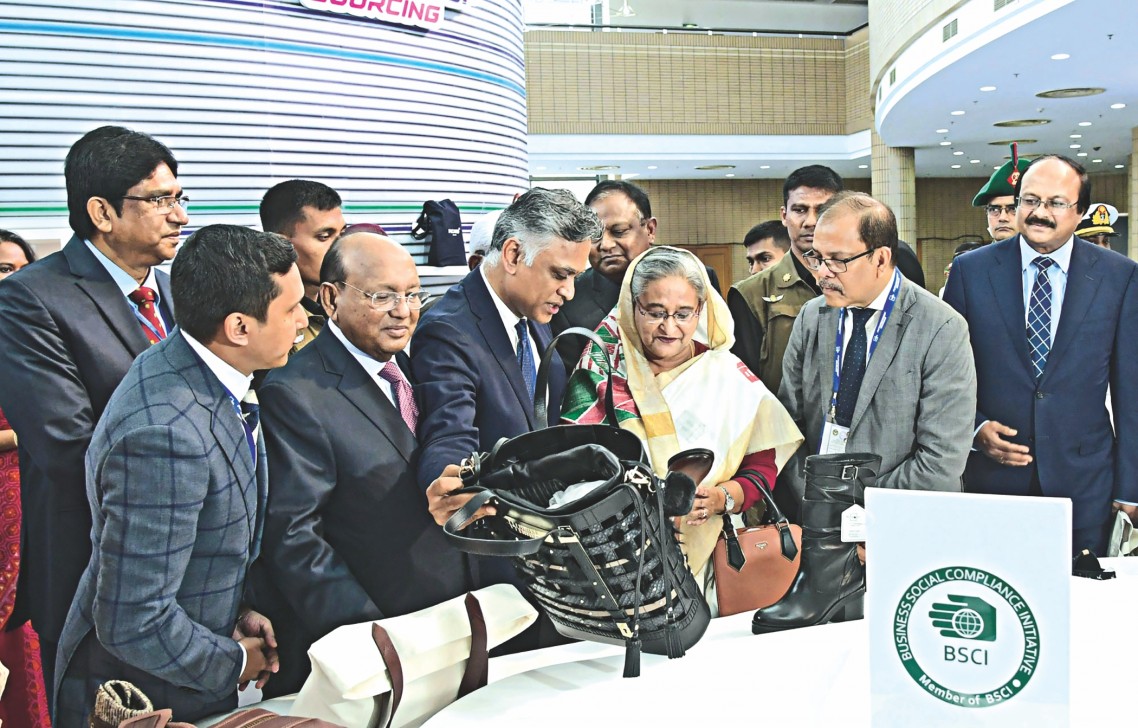Bangladesh turning into a hotspot for leather, leather goods

With great hopes, Yih Hang, a Taiwanese shoemaking machinery manufacturer, is participating in the 7th International Leathertech Show at the three-day International Convention City Bashundhara in Dhaka.
Last year, Yih Hang sold 30 shoe-making machinery, with prices ranging between $20,000 and $50,000.
“The demand for the machines is soaring here,” said Leon Ku, sales representative of the company, at his stall at the exhibition.
Ku already sold one machine worth $20,000.
Sales executives, brief visitors about a machine used in making leather shoes, at the seventh International Leathertech Show at International Convention City Bashundhara in Dhaka yesterday. Photo: Star
“Bangladesh is a prospective market for us as the leather and leather goods, shoes and the accessories industries are growing at a faster rate.”
It is not just Yih Hang -- almost all the local and international participants at the fair said now is the time to do business in Bangladesh as the sector is growing fast.
“We are expecting very good business in Bangladesh,” said Hafizul Islam, an executive of Zoje Bangladesh, a company that mainly sells sewing machines in the garment factories.
“Recently, we have started selling sewing machines for the shoe industries as the demand is rising,” said Islam.
Every year Zoje Bangladesh sells sewing machinery worth $16 million. Of the amount, a majority is shoe-making machinery, which was almost nothing in the past.
Md Rashedul Islam, marketing executive of Salsabil Trading Company, said: “This is a very good time for us. We are selling high-end shoe-making machinery as the demand is increasing.”
However, the demand for machinery would have increased manifold had the production facilities at the newly established Savar Tannery Industrial Estate (STIE) performed well, said leather and leather goods manufacturers and exporters at the show.
“Although the demand for leather and leather goods is very high among international buyers, we are not fully ready to make the most of the full potential,” said Maksudur Rahman, marketing manager of Salma Tannery at the STIE.
For instance, his company used to ship 5 lakh square feet of tanned leather every month previously, whereas it is very difficult to send even 3 lakh square feet of leather a month as Bangladesh cannot export to European markets owing to poor compliance and as the central effluent treatment plant (CETP) at the STIE has not been fully operational.
Recently, Japan, Korea, and Italy have almost stopped buying Bangladeshi leather for poor compliance.
The three countries used to buy a lot of Bangladeshi leather all year round, Rahman said.
Rahman’s company along with others sends leather to only China and to some other non-compliant buyers at nearly 40 percent less price.
Leather goods exporters do not get higher prices of their products unless the Leather Working Group (LWG), the global compliance audit organisation, certifies companies that they are compliant.
Since Bangladesh does not comply with the conditions of the LWG, local leather and leather goods exporters have to sell at much lower prices to buyers from China, who are not too fussed about compliance.
Bangladesh produces nearly 400 million square feet of rawhide, of which the local leather and footwear companies consume 30 million square feet.
Some leather goods and footwear companies import 20 lakh square feet high-quality leather to make exportable goods, according to industry insiders.
If the CETP is not fully functioning, exports will decline, said Saiful Islam, president of the Leathergoods and Footwear Manufacturers & Exporters Association of Bangladesh (LFMEAB).
The CETP should be working by now as its construction started a long time ago, he said.
“If we can comply, it would not be difficult to achieve our targeted export from the leather and leather sector in the next few years,” Islam said at a seminar at the exhibition, which will continue until November 2.
Last fiscal year, Bangladesh exported $1.01 billion worth of leather and leather goods, according to data from the Export Promotion Bureau.
More than 300 exhibitors from nearly 20 countries are showcasing finished leather products, machinery for tanning and manufacturing footwear and leather goods along with components like dyes and chemicals, accessories and allied products.
